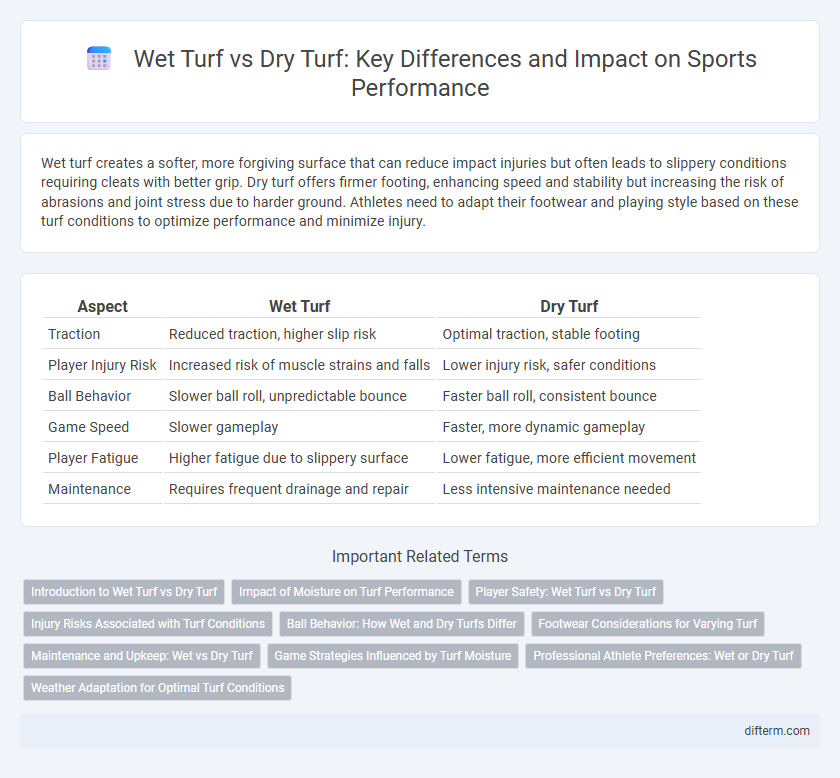Wet turf creates a softer, more forgiving surface that can reduce impact injuries but often leads to slippery conditions requiring cleats with better grip. Dry turf offers firmer footing, enhancing speed and stability but increasing the risk of abrasions and joint stress due to harder ground. Athletes need to adapt their footwear and playing style based on these turf conditions to optimize performance and minimize injury.
Table of Comparison
| Aspect | Wet Turf | Dry Turf |
|---|---|---|
| Traction | Reduced traction, higher slip risk | Optimal traction, stable footing |
| Player Injury Risk | Increased risk of muscle strains and falls | Lower injury risk, safer conditions |
| Ball Behavior | Slower ball roll, unpredictable bounce | Faster ball roll, consistent bounce |
| Game Speed | Slower gameplay | Faster, more dynamic gameplay |
| Player Fatigue | Higher fatigue due to slippery surface | Lower fatigue, more efficient movement |
| Maintenance | Requires frequent drainage and repair | Less intensive maintenance needed |
Introduction to Wet Turf vs Dry Turf
Wet turf presents a significantly different playing surface compared to dry turf, affecting ball behavior, player traction, and injury risk. Moisture on wet turf can cause slower ball roll and increased slipping hazards, while dry turf typically offers more consistent footing and faster ball movement. Understanding these distinctions is crucial for optimizing game strategies and player performance in various sports.
Impact of Moisture on Turf Performance
Moisture levels significantly influence turf performance, affecting traction, ball speed, and player safety during sports activities. Wet turf increases slipperiness, reducing traction and elevating the risk of slips and injuries, while dry turf offers more stability but can become hard and less forgiving on impact. Proper turf management considers moisture control to optimize playing conditions and maintain turf health throughout diverse weather conditions.
Player Safety: Wet Turf vs Dry Turf
Wet turf increases the risk of player injuries due to reduced traction and higher chances of slipping, leading to sprains or strains. Dry turf provides firmer footing, minimizing the likelihood of falls and promoting better stability during rapid movements. Proper field maintenance and appropriate footwear are essential to enhance player safety on both wet and dry playing surfaces.
Injury Risks Associated with Turf Conditions
Wet turf significantly increases the risk of lower limb injuries such as ankle sprains and knee ligament tears due to reduced traction and higher slip potential. Dry turf provides better footing, lowering the likelihood of sudden slips and muscle strains during rapid directional changes in sports. Proper maintenance and footwear selection tailored to turf conditions can mitigate injury risks and enhance athlete safety.
Ball Behavior: How Wet and Dry Turfs Differ
Wet turf significantly affects ball behavior by slowing the ball's roll and causing unpredictable bounces due to increased surface friction and softness. Dry turf allows for faster ball movement and more consistent, predictable bounces, enhancing control and precision in gameplay. Players often need to adjust their techniques to accommodate these variations in ball dynamics on wet versus dry surfaces.
Footwear Considerations for Varying Turf
Footwear selection is crucial for optimal performance on wet turf versus dry turf, as traction needs vary significantly between conditions. On wet turf, shoes with deeper, water-resistant cleats provide enhanced grip to prevent slipping, while dry turf requires lighter, shorter studs for speed and stability. Athletes must choose footwear designed specifically for turf conditions to maintain balance, agility, and minimize injury risks during play.
Maintenance and Upkeep: Wet vs Dry Turf
Wet turf requires more frequent aeration and drainage management to prevent waterlogging, mold growth, and soil compaction, resulting in higher maintenance costs. Dry turf demands consistent irrigation and drought mitigation strategies to maintain healthy grass and prevent brittleness or browning. Both conditions require tailored mowing schedules and fertilization plans to optimize turf resilience and playing surface quality.
Game Strategies Influenced by Turf Moisture
Wet turf significantly alters game strategies by reducing player speed and increasing the risk of slips, prompting teams to favor short, controlled passes over long sprints. Offensive plays adjust to minimize high-risk maneuvers, while defenses capitalize on slower movements to increase pressure and force turnovers. Coaches prioritize durability and traction in footwear choices to maintain stability on the slick surface, directly impacting play execution and stamina management.
Professional Athlete Preferences: Wet or Dry Turf
Professional athletes generally favor dry turf for enhanced traction and faster movement, reducing the risk of slipping and injury. Wet turf often leads to unpredictable footing, which can compromise performance, especially in high-speed sports such as football and soccer. Some athletes may prefer wet turf for improved ball control in specific conditions, but the consensus leans towards dry surfaces for optimal safety and stability.
Weather Adaptation for Optimal Turf Conditions
Wet turf requires specialized maintenance techniques to prevent soil compaction and promote drainage, ensuring durability during rainy weather. Dry turf benefits from strategic irrigation scheduling and drought-resistant grass species to maintain optimal growth and resilience in arid conditions. Weather adaptation strategies such as aeration for wet conditions and moisture retention practices for dry soil are crucial for sustaining high-quality sports turf performance.
wet turf vs dry turf Infographic

 difterm.com
difterm.com